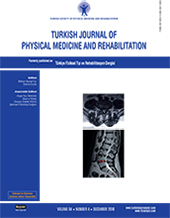The effects of body weight-supported treadmill training on static and dynamic balance in stroke patients: A pilot, single-blind, randomized trial
2 Department of Physiotherapy and Rehabilitation, Division of Physiotherapy and Rehabilitation, Istanbul Aydın University, Faculty of Health Sciences, Istanbul, Turkey
3 Department of Physiotherapy and Rehabilitation, Division of Physiotherapy and Rehabilitation, Istanbul University, Faculty of Health Sciences, Istanbul, Turkey
4 Department of Physical Medicine and Rehabilitation, Istanbul Physical Therapy Rehabilitation Training and Research Hospital, Istanbul, Turkey DOI : 10.5606/tftrd.2018.2672 Objectives: This study aims to compare effectiveness of isolated body weight-supported treadmill training (BWSTT) with conventional and combined training on balance, mobility, and fear of falling in stroke patients.
Patients and methods: Between November 2014 and November 2015, a total of 45 post-stroke patients (32 males, 13 females; mean age 53.1±13.2 years; range, 19 to 73 years) were randomly assigned to combined training group (CombTG), conventional training group (CTG), and BWSTT group (BWSTTG). The CombTG received 45 min conventional therapy for five days a week along with 45 min of BWSTT twice a week. The CTG received only conventional therapy for five days a week. The BWSTTG received only BWSTT twice a week. Training duration was six weeks for all groups. Primary outcome measures were the Berg Balance Scale (BBS), affected and non-affected side Single Leg Stance Test (e-SLST/n-SLST), and Timed Up and Go Test (TUG) results. Secondary outcomes were the Falls Efficacy Scale-International (FES-I), Rivermead Mobility Index (RMI), Comfortable 10-m Walk Test (CWT), and Stair Climbing Test (SCT) results.
Results: The mean change of outcome measures demonstrated that the improvements between groups were significantly different among the three groups, except for the CWT (p=0.135). In subgroup analysis, except for the RMI and CWT, all primary and secondary outcome measures improved significantly in favor of the CombTG, compared to the CTG and BWSTTG (p<0.016). However, no statistically significant difference was found in the mean change of the CTG and BWSTTG (p>0.05).
Conclusion: This study demonstrates that combined training has considerable effects on balance, mobility, and fear of falling parameters, while lower frequency of isolated BWSTT is as much effective as higher frequency of conventional training in ambulatory post-stroke patients.
Keywords : Accidental falls; mobility limitation; postural balance; rehabilitation; stroke

















